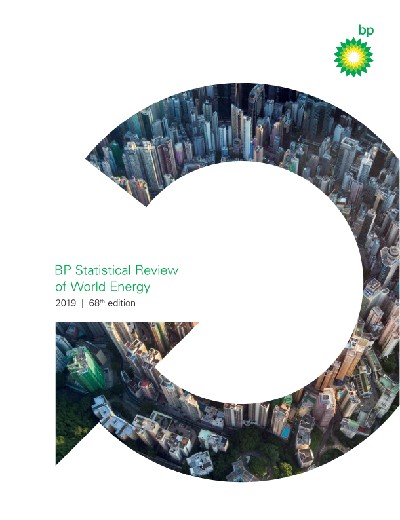"工业年鉴"相关数据
更新时间:2021-10-132019世界能源统计年鉴
In particular,the data compiled in this year's Review suggest that in 2018,global energy demand and carbon emissions from energy use grew at their fastest rate since 2010/11,moving even fur ther away from the accelerated transition envisaged by the Paris climate goals.
BP's economics team estimate that much of the rise in energy growth last year can be traced back to weather-related effects,as farmilies and businesses increased their demand for cooling and heating in response to an unusually large number of hot and cold days.The acceleration in carbon emissions was the direct result of this increased energy consumption.
Even if these weather effects are short-lived,such that the growth in energy demand and carbon emissions slow over the next few years,there seems lttle doubt that the current pace of progress is inconsistent with the Paris climate goals.The world is on an unsustainable path:the longer carbon emissions continue to rise,the harder and more costly will be the eventual adjustment to net-zero carbon emissions.Yet another year of growing carbon emissions underscores the urgency for the world to change.
The Statistical Review provides a timely and objective insight into those developments and how that change can begin to be achieved.
The strength iท energy consumption was reflected acroรs all the fuels,many of which grew more strongly than their recent historical averages.This acceleration was particularly pronounced for natural gas,which grew at one of its fastest rates for over 30 years,accounting for over 40% of the growth in primary energy.On the supply side,the data for 2018 reinforced the central importance of the US shale revolution.
【更多详情,请下载:2019世界能源统计年鉴】

工业互联网
工业互联网:产业超前布局,未来工厂会是什么模样?工业互联网主题数据包包含62项数据(32个数据报告、30个表格数据),数据包的大小为193MB。工业互联网指的是互联网和新一代信息技术与工业系统全方位深度融合所形成的产业和应用生态,是工业智能化发展的关键综合信息基础设施。其本质是以机器、原材料、控制系统、信息系统、产品以及人之间的网络互联为基础,通过对工业数据的全面深度感知、实时传输交换、快速计算处理和高级建模分析,实现智能控制、运营优化和生产组织方式变革。 如今,工业互联网在全球范围内引起了高度重视,全球工业互联网整体已经度过落地与商业模式探索期,正处于发展初期,进入了市场推广期。中国工业互联网经过三年的市场培育与沉淀,产业规模增加值从2017年的2.35万亿元增长至2019年的3.41万亿元,CAGR达到20.46%,整体产业迈向发展快车道。 本数据包对工业互联网的基本定义与行业术语进行了基本介绍,阐述了工业互联网的标准体系。此外,对于工业互联网的安全风险、应用场景、重点行业的数字化转型和优秀案例均有大篇幅的介绍与讲解,可以帮助读者全方位的了解工业互联网这一概念背后的深层含义和发展的重大意义。2016-2020年发布时间:2021-10-13工业机器人
工业机器人:复杂操作的神助力,效率安全的守护者工业机器人主题数据包包含69项数据(26个数据报告、43个表格数据),数据包的大小为54.2MB。工业机器人通常指面向制造业的多关节机械手臂,或其他拥有多自由度的机械装置,主要用来代替人工从事柔性生产环节。它融汇了机械制造、电机电器、材料科学、计算机编程等学科的尖端技术。 本数据包从资本角度出发,带你了解中国和全球工业机器人市场的巨大成长空间。随着工业制造向智能制造的方向发展,全球制造业产业结构发生转型升级的时代背景下,占据智能制造半壁江山的工业机器人需求量持续攀升。科创板扶持“硬科技”,这是加速机器人证券化的重大利好,产业迎来十年难遇的独角兽投资机会。 本数据包介绍了工业机器人的零部件及上下游产业链,也描述了工业机器人的历史和未来发展方向,还从地域维度统计对比了工业机器人的销量、销售额、出货量、专利数量、市场结构等指标差异,旨在帮助用户快速了解工业机器人领域的相关情况。2007-2019年发布时间:2021-08-04石油工业
石油工业:经济增长带动中国石油需求市场攀升石油工业主题数据包包含54项数据(10个数据报告、44个表格数据),数据包的大小为50.3MB。石油是现代工业必需品,对于世界经济至关重要,从石油中分离出来的燃油和汽油是世界上最重要的一次性能源。同时石油提取物,如沥青、石蜡、烷烃类化合物、液化石油气等产品是化学工业产品;也是药物、清洁剂、油漆、溶液、化肥、杀虫剂、润滑油和塑料等产品必不可少的基础原料。 在过去20年,中国对于石油需求巨大,截止2015年日均消耗量达到1200万桶。世界上主要的石油生产国有沙特阿拉伯、俄罗斯、美国、伊拉克、伊朗、中国、加拿大和阿联酋,其中沙特阿拉伯2018年底探明石油储量2977亿桶。 本数据包既收录了中国生产和消费的石油加工量、消费量、石油炼厂产能以及石油产量;又展示了天然气、管道相关数据,以及石油公司利润和公司下属业务情况等,旨在帮助用户快速了解石油工业行业的发展现状。1970-2050年发布时间:2020-11-25





